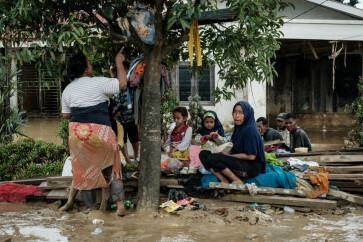Popular Reads
Top Results
Can't find what you're looking for?
View all search resultsPopular Reads
Top Results
Can't find what you're looking for?
View all search resultsNTT prepared for drought, S. Sumatra, C. Sulawesi suffer
The East Nusa Tenggara (NTT) provincial administration claimed to have anticipated the drought by making various mitigation efforts while several areas in Central Sulawesi and South Sumatra are still suffering from the prolonged dry season
Change text size
Gift Premium Articles
to Anyone
T
he East Nusa Tenggara (NTT) provincial administration claimed to have anticipated the drought by making various mitigation efforts while several areas in Central Sulawesi and South Sumatra are still suffering from the prolonged dry season.
'We were very prepared for the drought and anticipated the El Niño weather phenomenon, including coordinating with regents and mayors to handle the situation in the fields,' said NTT Governor Frans Lebu Raya in a radio and television address as well as in online and print media in Kupang ahead of Indonesia's 70th Independence Day celebrations on Sunday.
Frans said the NTT Public Works and People's Housing Office had provided water tankers as well as building artesian wells in regions affected by the drought.
He said the drought so far had not affected food supplies in NTT, and they remained sufficient until now, thanks to the reserves of 200 tons of rice in the province, and 100 tons of rice in regencies and cities stored to anticipate food shortages.
Despite the sufficient food reserves, Frans urged the community in NTT to consume local staples, like maize, which is less favored.
'I call on journalists to promote eating corn, as it doesn't mean you're poor. Eating corn does not lower our dignity, but instead raises it, as we eat from the yields of our hard work,' said Frans.
According to Frans, based on data as of April 2015, corn production in NTT increased more than 6,000 tons. By the end of this year, corn production is estimated to have risen more than 7,000 tons.
'That's just from corn, not to mention beans, tubers and others. We must strengthen our understanding of food because we always think about rice,' he said.
In contrast, 247 hectares of soybean plants have reportedly suffered crop failure in several regencies in South Sumatra due to the drought, Antara reported on Monday.
An official at the province's Agriculture and Food Plants Agency, M Zuhri, said crop failures happened in Tungkal Ilir district, Banyuasin regency, Sosoh Buay Rayap district, Ogan Komering Ulu regency, and Central Kikim district, Lahat regency.
Zuhri also revealed 483 hectares of corn fields and 434 hectares of paddy farmland had suffered crop failures in the current drought.
Meanwhile, a number of regions in Central Sulawesi, such as Sigi, Palu, Tolitoli and Buol, have been hit by drought.
River levels, in a number of regions in Sigi and Palu have lowered further over the past several days, such as the Palu River, which bisects West Palu and South Palu districts.
The Gumbasa River level in Sigi has also receded but has yet to disrupt water supplies to irrigate rice fields.
However, in a number of areas, water to irrigate farmland has further declined, as farmers in Dolo district, Sigi, are forced to buy water to irrigate their fields.
'If they don't buy water they would suffer more losses,' said Central Sulawesi Agriculture Office head Tri Lamakampali.
The drought in Central Sulawesi has depleted the wells in residents' houses in Palu. Housewife Ani, of Besusu subdictrict, East Palu, complained of the depleting water in her well. 'However, my house is located near the Palu River,' said Ani.










